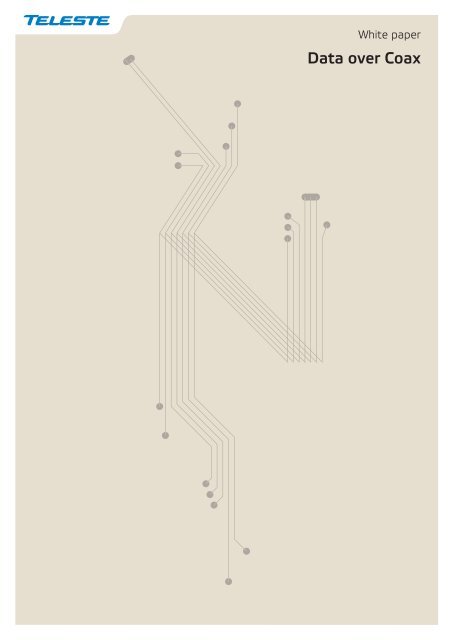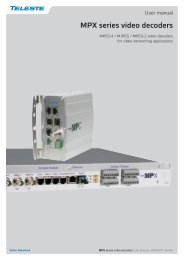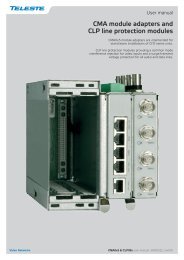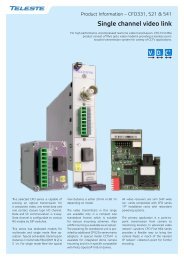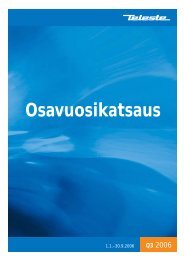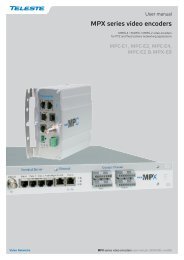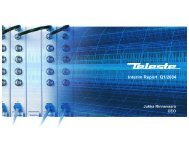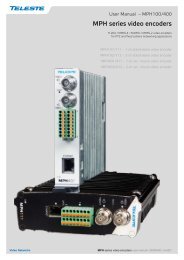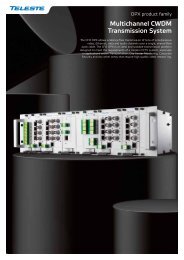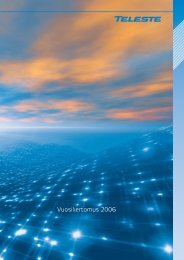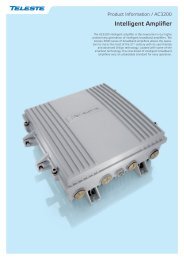Data over Coax - CSI Magazine
Data over Coax - CSI Magazine
Data over Coax - CSI Magazine
You also want an ePaper? Increase the reach of your titles
YUMPU automatically turns print PDFs into web optimized ePapers that Google loves.
White paper<strong>Data</strong> <strong>over</strong> <strong>Coax</strong>
<strong>Data</strong> <strong>over</strong> <strong>Coax</strong> – quality service at lower costsWith the growing popularity of OTT video services and high definition video formats,broadband users will need significantly higher bandwidth in the future. Fibre to the Homewould provide sufficient speeds, but bringing fibre connections to people’s homes is fartoo expensive in a typical European apartment building.However, there is a simple solution. <strong>Data</strong> <strong>over</strong> <strong>Coax</strong> (DoC) provides a versatile and costefficientalternative for bringing high-speed broadband connections to customers byusing existing coaxial cabling – for under one-fifth of the price compared to FttH. In thiswhitepaper, we discuss <strong>Data</strong> <strong>over</strong> <strong>Coax</strong>’s architecture and the merits of different DoCtechnologies.BackgroundChanging TV consumer habits and the migration fromlinear TV to on-demand services (OTT, IPTV or unicastDVB, VoD, catch-up, NPVR, etc.) will drive broadbandconnectivity speeds to a new level. This is being furtheraccentuated with the emergence of new video formats(HD, Ultra-HD, 3D). A downstream speed of 10Mbps isno longer adequate for a high-quality consumer experience– within the next five years, operators will have tooffer guaranteed speeds of at least 30Mbps to each customer,and even 100Mbps per customer will be normal.The most likely model to deliver these services will besome type of <strong>over</strong>-the-top delivery – meaning that theback-office service platform will be able to deliver TV content<strong>over</strong> unmanaged broadband access networks andinto retail market consumer devices. The drivers for OTTdelivery are as follows:• Mobile TV services can be offered – both in-home andwhile on the go• The service can be marketed to all consumers – not onlyto those who are connected via the service provider’sown access network• The service can be made compatible with various typesof end devices• The creation and management of the service can predominantlybe done in the back-office / cloud, with thebenefit of limited software complexity at the end-userdevice levelFor existing linear-TV services, DVB distribution remainsthe superior technology, due to both superior CAPEX /OPEX benefits and also consumer experience (simplicity,zapping-time, elimination of STBs, etc).Therefore, we can make the following list of basic requirementsfor the next generation of access networks:• DVB distribution for mainstream linear TV services• Guaranteed subscriber line speeds from 30Mbps to100Mbps and beyond for IP video streaming. Lowlatency to enable cloud architecture and services such ason-line games• CAPEX with reasonable payback periods and clear ROI.The investments will preferably be based on a pay-asyou-growmodel• Future-proof topology for the inevitable outside fibreplant construction• Streamlined subscriber provisioning and managementto reach a low OPEX and fast subscriber help-desk support• Standard interface between the subscriber modems andaccess networks, enabling multivendor interoperabilityand subscriber modem distribution via retail sales channelsSubject to the operator’s business strategies, the followingspecific requirements may also need consideration:• Analogue TV distribution• FM radio distribution• The capability of utilizing the same access network tohandle traffic from several service providers and of evenusing different broadband access technologiesThe required speeds can be achieved with Fiber to theHome (FttH), but the cost of building such networks, particularlywithin the infrastructure of an existing building,does not give reasonable return on investment.As FttH is simply too expensive in locations other thangreen field areas, the operators need some other waysto deliver high-speed broadband to their subscribers. Themain cost in FttH installations comes from the last tenor hundred metres close to home and inside the building.
Just like with plumbing repairs, the cost does not comefrom the plumbing itself, but from the labour, which is acost that is difficult to reduce.In this document, different <strong>Data</strong> <strong>over</strong> <strong>Coax</strong> (DoC) technologiesare introduced and the main characteristicsexplained.Being able to exploit existing cabling infrastructuresenables the operator to achieve a better return on investmentand a faster roll-out of high-speed connections.Recent research suggests that it costs between 2000and 3000 euros to build a fibre connection to a singleapartment. By using <strong>Data</strong> <strong>over</strong> <strong>Coax</strong> technology, this canbe cut down to one-fifth the cost or less.The last-mile coax plant is an attractive infrastructureand the quality of the physical medium is undisputed. Itis possible already today to deliver the needed speeds<strong>over</strong> the coax plant, unlike, for example, <strong>over</strong> a twistedpair network, where such speeds are hard to achieve inreal network conditions and with high levels of subscriberpenetration.One key benefit of a coax plant is its inherent capabilityto simultaneously deliver both DVB services and broadbandaccess – and even analogue TV and FM radio.Architecture for <strong>Data</strong> <strong>over</strong> <strong>Coax</strong>The architecture of the proposed access network is relativelystraightforward. The passive part of a coax plant isused to gain access to individual households. Those coaxsegments are served by using traditional point-to-pointEthernet technology or some form of Passive OpticalNetwork (PON) technologies.Even today, there are several DoC technologies thatcan fulfil either completely or partly the previously listedrequirements and others will be coming to the market inthe near future. Probably the best-known DoC technologyis DO<strong>CSI</strong>S (<strong>Data</strong> <strong>over</strong> <strong>Coax</strong> Service Interface Specification);its latest release, DO<strong>CSI</strong>S 3.0, is already beingwidely deployed. Other possible technologies includeMoCA (Multimedia <strong>over</strong> <strong>Coax</strong> Alliance), ITU G.hn and IEEEP1901. All these technologies are briefly introduced inthe following section.CPEOpticalEthernetAccessOE<strong>Coax</strong>Adaptation<strong>Coax</strong> NetworkSimplified optical access and <strong>Data</strong> <strong>over</strong> <strong>Coax</strong> architecture
Different <strong>Data</strong> <strong>over</strong> <strong>Coax</strong> bandplansFMG.hn PLC /IEEE P1901(EURO)DO<strong>CSI</strong>S 3.0USCATV(EURO)DO<strong>CSI</strong>S 3.0 DSG.hn RFHPNA3.1EoC-S100EPoCUSMoCA 2.0EPoC DS32 65 87 108350 450 1000 1500 2000 3000 MHz<strong>Data</strong> <strong>over</strong> <strong>Coax</strong> technologiesuCMTS / Broadcom CMCThe traditional ideology is that DO<strong>CSI</strong>S technologiesshould have a CMTS at the head-end to feed hundredsof cable modems. However, as the dedicated speed percustomer is on the rise, the size of each data segmentis getting smaller and smaller. With the introduction ofBroadcom’s DO<strong>CSI</strong>S®-based Ethernet <strong>over</strong> <strong>Coax</strong> (EoC)technology, it is now possible to move the CMTS fromthe head-end closer to the customer. This opens up newopportunities for using DO<strong>CSI</strong>S as the last-mile accesssolution together with P2P / PON Ethernet trunk networks.The main benefits of DO<strong>CSI</strong>S based DoC solutions are asfollows:• Widely adopted, mature standard c<strong>over</strong>ing OSI layers 1-3• Wide selection of subscriber modems in volumes• Proven to work in a coax network with active equipment;it is also possible to run analogue TV, FM radio and DVBservices• In the case of an operator running a DO<strong>CSI</strong>S service, theDoC infrastructure would be compatible with existingback-office systems and existing cable modems• In the case of an operator having installed a base ofCMTSs, there can be a gradual evolution to DoC architecturewith no stranded assetsThe main challenges are as follows:• Unnecessary complexity in the case of a totally passivecoax plant with a higher CAPEX / OPEX compared toother DoC alternatives• A high-quality, two-way-capable coax plant is a prerequisite• Current DO<strong>CSI</strong>S provisioning standard is not compatiblewith, e.g., GPON• Only one silicon manufacturer committed to this technology,which may prevent price erosionITU G.hnITU G.hn is a next-generation, unified coaxial, phone lineand power line home networking standard. Even if themain target for this standard is in-home networks, thesame technology can also be used in access networkswhen the access features are implemented on top of thestandard-based solution.The G.hn power line standard uses frequencies below100MHz. As the technology is originally meant for powerline communication, the robustness and error correctiontechnologies are state of the art. In a coax environment,the expected throughput is approximately 600Mbps (halfduplex),which is shared by the shared. In practice, thismeans that if 30Mbps per customer is needed, then thesystem can feed approximately 20 customer connections.
With such connection numbers, latency is also well undercontrol.The G.hn standard also includes the possibility to use higherfrequencies, starting from 450MHz. In networks wherethe cable TV services are not using the 600 … 860 (1000)MHz area, the use of higher frequencies is a good choice.The G.hn uses 100MHz contiguous frequency blocks withthe possibility to notch selected frequencies.G.hn chipsets are currently available and the access featurefirmware will be available probably at some point during2012.The main benefits of the G.hn based DoC solution are asfollows:• Even a lower-quality passive coax plant can typically beused – without needing to make the plant two-waycapable• Makes it possible to also run analogue TV, FM radio andDVB services in the same coax• ITU-T standards (for layers 1 & 2) exist• If ITU G.hn becomes the winning standard for homenetworking, chip-set prices will drop significantly• DO<strong>CSI</strong>S can co-exist when high frequencies (450MHz…)are usedThe main challenges are as follows:• Lack of standard c<strong>over</strong>ing, also for layer 3, e.g. provisioning• More limited availability of subscriber modems (today)• Does not work in a coax plant with amplifiers withoutspecial arrangements• Uses the same frequencies as DO<strong>CSI</strong>S upstream ifpower-line frequencies (0…100MHz) are usedIEEE P1901IEEE P1901 is a similar technology as ITU G.hn. The maindifference has been that the IEEE only included a powerline in a standard network. Now, the IEEE works onP1905.1 (Standard for a Convergent Digital Home Networkfor Heterogeneous Technologies) standard, whereother mediums are also included.The IEEE P1901 uses frequencies of up to 70MHz anddelivers approximately 500Mbps (half-duplex) throughput,which is shared by the users. Large volumes ofP1901 chipsets are available already today.As the main players in the P1901/P1905.1 standardare mainly focused on in-home connectivity and not onaccess solutions, using this technology does not seemfeasible.DIGITAL FUTURE. Revolution in communication leads to the explosion of digital network content.
MoCA 2.0The Multimedia Over <strong>Coax</strong> Alliance has ratified a new2.0 standard in which lower frequencies (starting from500MHz center frequency) can now be used as well. Theuse of frequencies <strong>over</strong> 1GHz has not been successfuldue to the coax network passive’s behaviour at such highfrequencies (attenuation, return loss, isolation). In the 2.0specification, the expected throughput is approximately400Mbps, and there is also the possibility to bond twochannels together to achieve 800Mbps speeds.Compared to the G.hn, the MoCA is still predominantlya US-based, in-home technology. The standardization isg<strong>over</strong>ned by MoCA and there is only one major siliconvendor. The latest developments suggest that MoCAstandards will be merged with G.hn or IEEE P1901 /1905.1 standards.MoCA 2.0 chipsets are not yet available, but they shouldbe available at some point during 2012. MoCA 1.1 alsoincludes access features, but the availability of the 2.0access feature firmware is still unknown.The main benefits of the MoCA 2.0 based DoC solutionsare as follows:• Even a lower-quality passive coax plant can typicallybe used – without needing to make the plant two-waycapable• It makes it possible to also run analogue TV, FM radioand DVB services in the same coax• Good line-speed• If MoCA 2.0 becomes the winning standard for homenetworking, chip-set prices will drop significantlyThe main challenges are as follows:• Because 2.0 chipsets are not yet available, product implementationsare coming later than those for competingDoC technologies• Formal standards are still not mature• Does not work in a coax plant with amplifiers withoutspecial arrangementsNote: MoCA 1.0 / 1.1 chipsets are available today, buttheir use is not considered here because it is not feasibleto use such high frequencies in coax access networks.SUMMARYWith the advent of HD and OTT video services, consumers need a very high bandwidth and almost fibre-level connectionsto their homes. However, in a typical European apartment building, bringing fibre connections all the wayto consumers’ homes is too expensive to be a viable business for operators. The main cost comes from buildingthe connections to individual apartments. This cost can be reduced to one-fifth the initial cost by bringing fibre connectionsto an apartment building (FttB) and by utilizing existing coaxial cables to connect individual apartments.The new <strong>Data</strong> <strong>over</strong> <strong>Coax</strong> technologies enable operators to bring fibre-level connection speeds to consumers byutilizing existing cabling – for one-fifth the price. DoC technologies offer attractive options for building professional,standard-based, next generation FTTB networks. The base technologies exist already today or will be coming inthe immediate future.When out-of-band technologies are considered, G.hn and MoCA (2.0) are the main technologies. Choosing betweenthese two technologies depends mainly on the quality of the coax access plant. Another key factor is the volumemarket adaptation of these technologies.The Broadcom DO<strong>CSI</strong>S®-based Ethernet <strong>over</strong> <strong>Coax</strong> (EoC), also known as CMC (<strong>Coax</strong> Media Converter), is an interestingconcept when in-band communication can be used. This technology can be more flexibly deployed becauseit is designed to operate in existing quality HFC networks. The massive volume CPE availability makes the launchof the technology straightforward.Teleste has been a pioneer in the field of <strong>Data</strong> <strong>over</strong> <strong>Coax</strong> technologies. First-generation products and field deploymentswere launched in 2006. We are now engaged in evaluation and field tests with 2nd generation chipsetsthat offer greatly improved performance as well as solid standards. Teleste is in a unique position to innovate inthis field due to our intimate knowledge of the HFC infrastructure as well as IP networking. Additionally, Telestecan offer these technologies as a “Build – Operate – Transfer” solution with our field force of optical and coaxnetwork professionals.
Teleste is an international technology group founded in 1954, which is specialised in broadband video and datacommunication systems and services. The group is active in two business segments, Video and Broadband Solutionsand Network Services; in both fields, we are among the global leaders. Video is at the core of our business activities,with a focus on the processing, transmission and management of video and data for operators and public authorities.In 2011 the group’s net sales totalled almost EUR 184 million. The company has nearly 30 offices world-wideand <strong>over</strong> 90% of Teleste’s net sales are generated outside Finland. The company is listed on the NASDAQ OMXHelsinki Ltd. Visit www.teleste.com for more information.Teleste CorporationP.O.Box: 323, FI-20101 Turku, FinlandPhone: +358 2 2605 611Fax: +358 2 2446 928video.headends@teleste.comwww.teleste.comP3I_<strong>Data</strong> <strong>over</strong> <strong>Coax</strong> Copyright © 2012 Teleste Corporation. All rights reserved. TELESTE is a registered trademark of Teleste orporation.


